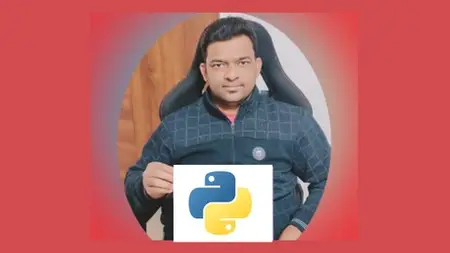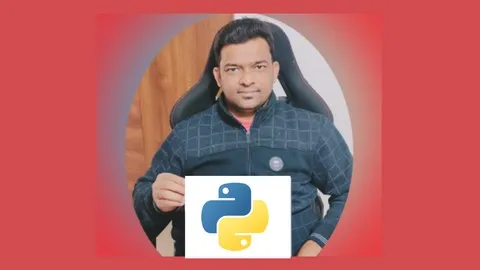Master Python Programming: Python Full Course For Beginners
Published 8/2025
MP4 | Video: h264, 1920x1080 | Audio: AAC, 44.1 KHz
Language: English | Size: 4.80 GB | Duration: 12h 6m
Published 8/2025
MP4 | Video: h264, 1920x1080 | Audio: AAC, 44.1 KHz
Language: English | Size: 4.80 GB | Duration: 12h 6m
Python Programming - Basics, OOP, Error Handling, File Handling, Lists, Sets, Tuples, Sets, Dictionary, NumPy, MySQL
What you'll learn
Python Basics: syntax, variables, indentation, and comments.
Python Operators: arithmetic, comparison, logical, and assignment operators.
Data Types: integers, strings, floats, booleans, and type casting.
Control Flow: if, if-else, elif, nested if, match-case.
Loops: for loop, while loop, break, continue, and pass.
Strings: string methods, f-strings, formatting, and manipulation.
User Input: interactive programs with projects.
Python Modules and Packages
Functions: creating functions, scope, and reusable code.
OOP in Python: classes, objects, inheritance, encapsulation, abstraction, polymorphism.
Data Structures: lists, tuples, sets, and dictionaries — with practical examples.
File Handling: reading, writing, appending, deleting, renaming files
Exception Handling: try-except, else, finally, raise, custom exceptions.
Python Programs: 15+ real coding examples to practice your skills.
Master NumPy Library
Requirements
No Python programming experience needed. You will learn everything you need to know
Description
Python is one of the most popular and beginner-friendly programming languages in the world. From web development and data analysis to artificial intelligence and automation, Python is everywhere — and learning it opens the door to endless career opportunities.This course is designed as a complete Python learning path for absolute beginners. You don’t need any prior programming experience — we start from scratch and build up step by step until you’re confident in writing Python code on your own.What is Python?Python is an interpreted, object-oriented, high-level programming language known for its readability and simplicity.It allows you to write code quickly and efficiently, making it ideal for beginners and experienced programmers.Python supports multiple programming paradigms, including procedural, object-oriented, and functional programming.Python was created by Guido van Rossum and first released in 1991.Programmers can easily read and understand a Python program because it has basic, English-like syntax.Python makes programmers more productive because they can write a Python program using fewer lines of code compared to many other languages.What You’ll Learn in This CourseInstall Python and set up your development environment.Understand Python syntax, indentation, variables, and commentsWork with operators, data types, and type casting.Write dynamic programs using control statements and loopsMaster Python strings and their built-in methodsAccept and process user input with interactive programsCreate reusable code with functions and explore variable scope.Learn Object-Oriented Programming (OOP): classes, objects, inheritance, encapsulation, abstraction, and polymorphismWork with Python collections: lists, tuples, sets, and dictionaries.Handle files in Python: reading, writing, appending, deleting, and renamingWrite safer programs with exception handling (try-except, else, finally, and custom exceptions)Practice with beginner-friendly Python programs and coding challengesOrganize code with modules and packages.Get introduced to NumPy for numerical operations and array processingWhy Learn Python?1. High Demand and Job OpportunitiesPython is one of the most popular programming languages, and its demand continues to grow in various industries, including technology, finance, healthcare, and education. Learning Python can open up numerous job opportunities.2. Versatility and FlexibilityPython’s versatility allows it to be used in a wide range of applications, from web development and automation to data science and artificial intelligence. Its flexibility makes it a valuable skill for any developer.3. Strong Community SupportPython has a large and active community that contributes to its rich ecosystem of libraries and frameworks. This community support ensures that developers have access to a wealth of resources, tutorials, and tools.4. Easy to Learn and UsePython’s straightforward syntax and readability make it an ideal language for beginners. Its ease of use allows developers to quickly write and understand code, speeding up the learning process.5. Powerful Libraries and FrameworksPython boasts a vast array of libraries and frameworks that facilitate various programming tasks, from data analysis and visualization to web development and machine learning.Whether you want to start a career in programming, enhance your current skills, or simply explore coding as a hobby, this course is your step-by-step guide to mastering Python.Enroll today and start your Python journey!
Overview
Section 1: Introduction to Python Programming
Lecture 1 What is Python Programming?
Lecture 2 Installing Python and PyCharm on Windows (Step-by-Step Setup)
Lecture 3 Creating First Python Project and Python Program in PyCharm
Lecture 4 How Python Works
Lecture 5 Python Comments
Lecture 6 Python Variables
Lecture 7 Python Syntax and Indentation
Section 2: Python Operators
Lecture 8 Python Arithmetic Operators
Lecture 9 Python Assignment Operators
Lecture 10 Python Comparison Operators
Lecture 11 Python Logical Operators
Section 3: Python Data Types
Lecture 12 Python Data Types
Lecture 13 Type Casting in Python
Section 4: Python Control Statements
Lecture 14 if statement in Python
Lecture 15 if-else Statement in Python
Lecture 16 elif Statement in Python
Lecture 17 Nested if Statement in Python
Lecture 18 Python match-case Statement
Section 5: Python Loops
Lecture 19 Python for Loop
Lecture 20 Python while Loop
Lecture 21 Python break Statement
Lecture 22 Python continue statement
Lecture 23 Python pass Statement
Section 6: Python Strings
Lecture 24 Python Strings
Lecture 25 Python String Methods - Part 1
Lecture 26 Python String Methods - Part 2
Lecture 27 Python String Methods - Part 3
Lecture 28 F-Strings in Python
Section 7: Python User Input
Lecture 29 Python User Input
Lecture 30 Python User Input - Build a Simple Registration and Login Program in Python
Section 8: Python Functions
Lecture 31 Python Functions
Lecture 32 Python Variable Scope
Section 9: Python Modules
Lecture 33 Introduction to Python Modules
Lecture 34 Using Built-in Modules
Lecture 35 Create Custom Module in Python
Section 10: Python Packages
Lecture 36 Introduction to Python Packages
Lecture 37 Create Python Package
Lecture 38 Python Package Exercise - Organizing Utility Functions
Section 11: Python OOP (Object-Oriented Programming)
Lecture 39 Classes and Objects in Python
Lecture 40 Classes and Objects in Python - Advanced
Lecture 41 Python Constructors
Lecture 42 Encapsulation in Python
Lecture 43 Abstraction in Python
Lecture 44 Inheritance in Python - Theory
Lecture 45 Python Inheritance Example
Lecture 46 Types of Inheritance in Python
Lecture 47 Single Inheritance in Python
Lecture 48 Multiple Inheritance in Python
Lecture 49 Multilevel Inheritance in Python
Lecture 50 Hierarchical Inheritance in Python
Lecture 51 Polymorphism in Python
Lecture 52 Python Abstract Classes
Section 12: Python Lists
Lecture 53 Python Lists - Introduction
Lecture 54 Creating a List in Python
Lecture 55 Accessing Elements by Index in List in Python
Lecture 56 Updating List Items in Python
Lecture 57 Adding Items to a List in Python
Lecture 58 Removing Items from a List in Python
Lecture 59 Looping Through a List
Lecture 60 Slicing a List in Python
Lecture 61 Checking If an Item Exists in a Python List
Lecture 62 len(), index(), and count() methods
Lecture 63 Sorting a List in Python
Lecture 64 Copying a List in Python
Lecture 65 Merging or Combining Lists in Python
Section 13: Python Tuples
Lecture 66 Introduction to Tuple
Lecture 67 Creating Tuples in Python
Lecture 68 Accessing Elements in a Tuple
Lecture 69 Looping Through a Tuple in Python
Lecture 70 Slicing Tuples in Python
Lecture 71 Nested Tuples in Python
Lecture 72 Converting Between Tuples and Lists in Python
Section 14: Python Sets
Lecture 73 Introduction to Set
Lecture 74 Create Set in Python
Lecture 75 Add and Update Sets in Python
Lecture 76 Remove Items from Sets in Python
Lecture 77 Union of Sets in Python
Lecture 78 Intersection of Sets in Python
Lecture 79 Difference of Sets in Python
Lecture 80 Symmetric Difference in Python
Lecture 81 Loop Through a Set in Python
Section 15: Python Dictionaries
Lecture 82 Introduction to Python Dictionary
Lecture 83 Creating a Dictionary in Python
Lecture 84 Accessing Items in a Dictionary
Lecture 85 Updating and Adding Items in a Dictionary
Lecture 86 Nested Dictionaries in Python
Section 16: File Handling in Python
Lecture 87 Introduction to Python File Handling
Lecture 88 Python Write to File
Lecture 89 Read Files in Python
Lecture 90 Python Exception Handling in File Write and Read Operations
Lecture 91 Python Delete File
Lecture 92 Python Append File
Lecture 93 Python Rename File
Lecture 94 Python List Files in a Folder
Section 17: Exception Handling in Python
Lecture 95 Introduction to Python Exception Handling
Lecture 96 Python try-except Block
Lecture 97 Python Exception Handling with else and finally
Lecture 98 Python Raising Exceptions using the raise Keyword
Lecture 99 Custom Exception Classes in Python
Section 18: Python Programs
Lecture 100 Python Program to Add Two Numbers
Lecture 101 Python Program to Find the Largest of Three Numbers
Lecture 102 Python Program to Check if a Number is Positive, Negative, or Zero
Lecture 103 Python Program to Check if a Number is Odd or Even
Lecture 104 Python Program to Calculate the Square Root
Lecture 105 Python Program to Generate a Random Number
Lecture 106 Python Program to Calculate the Area of a Triangle
Lecture 107 Python Program to Check if a Number is Prime
Lecture 108 Python Program to Find the Sum of Natural Numbers
Lecture 109 Python Program to Calculate the Factorial of a Number
Lecture 110 Python Program to Check Armstrong Number
Lecture 111 Python Program to Print Fibonacci Series
Lecture 112 Python Program to Check If a String is a Palindrome
Lecture 113 Python Program to Swap Two Variables With and Without a Temporary Variable
Section 19: Python NumPy
Lecture 114 NumPy Introduction
Lecture 115 NumPy Creating Arrays
Lecture 116 NumPy Array Indexing
Lecture 117 Slicing One-Dimensional Arrays in NumPy
Lecture 118 Slicing Two-Dimensional Arrays using NumPy
Lecture 119 NumPy Data Types
Lecture 120 NumPy Array Shape
Lecture 121 NumPy Array Reshape
Lecture 122 NumPy Iterating Arrays
Lecture 123 NumPy Joining Arrays
Lecture 124 NumPy Array Splitting
Lecture 125 NumPy Searching Arrays
Lecture 126 NumPy Sorting Arrays
Lecture 127 NumPy Filter Arrays
The programmer who want to learn Python programming faster in just 30 days.



